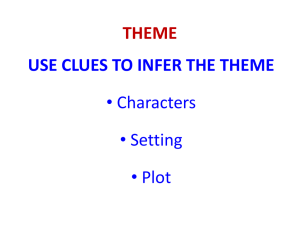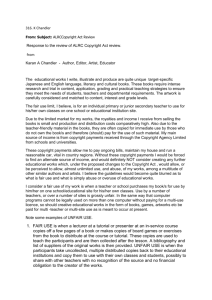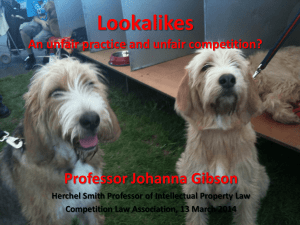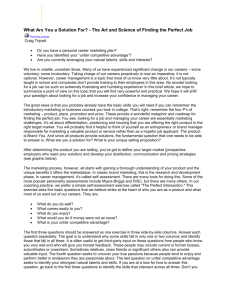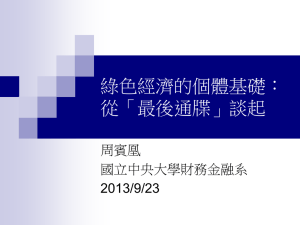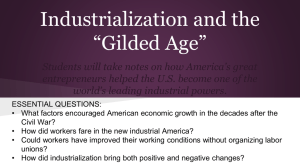The Neural Basis of Economic Decision-Making in the
advertisement
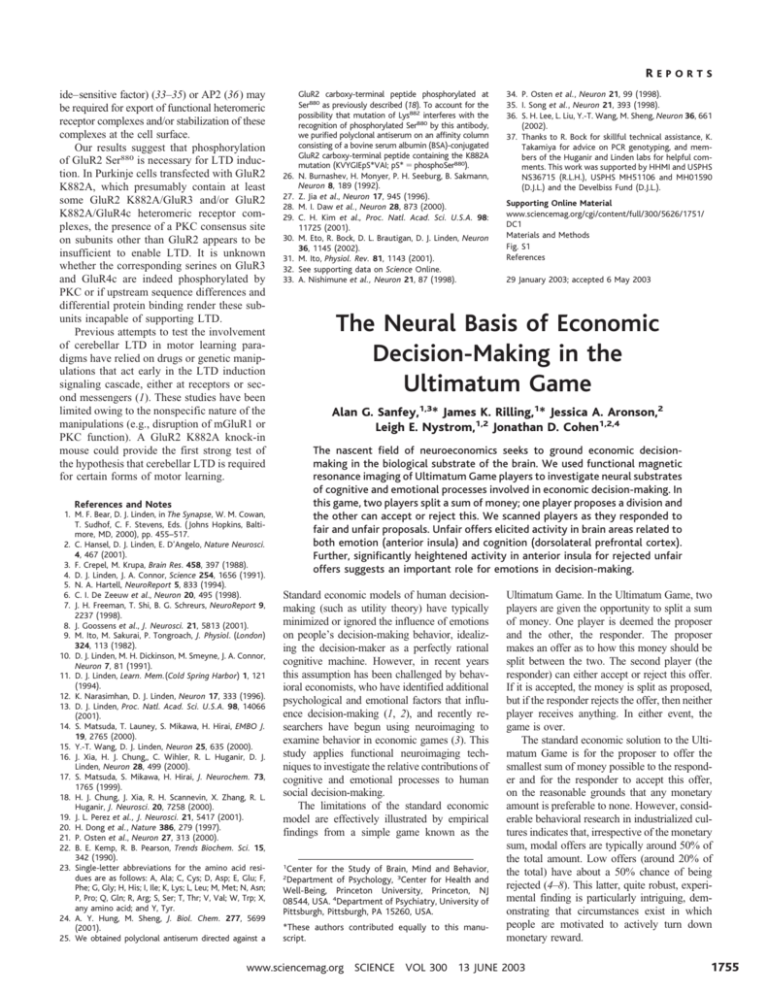
REPORTS ide–sensitive factor) (33–35) or AP2 (36) may be required for export of functional heteromeric receptor complexes and/or stabilization of these complexes at the cell surface. Our results suggest that phosphorylation of GluR2 Ser880 is necessary for LTD induction. In Purkinje cells transfected with GluR2 K882A, which presumably contain at least some GluR2 K882A/GluR3 and/or GluR2 K882A/GluR4c heteromeric receptor complexes, the presence of a PKC consensus site on subunits other than GluR2 appears to be insufficient to enable LTD. It is unknown whether the corresponding serines on GluR3 and GluR4c are indeed phosphorylated by PKC or if upstream sequence differences and differential protein binding render these subunits incapable of supporting LTD. Previous attempts to test the involvement of cerebellar LTD in motor learning paradigms have relied on drugs or genetic manipulations that act early in the LTD induction signaling cascade, either at receptors or second messengers (1). These studies have been limited owing to the nonspecific nature of the manipulations (e.g., disruption of mGluR1 or PKC function). A GluR2 K882A knock-in mouse could provide the first strong test of the hypothesis that cerebellar LTD is required for certain forms of motor learning. 26. 27. 28. 29. 30. 31. 32. 33. 34. P. Osten et al., Neuron 21, 99 (1998). 35. I. Song et al., Neuron 21, 393 (1998). 36. S. H. Lee, L. Liu, Y.-T. Wang, M. Sheng, Neuron 36, 661 (2002). 37. Thanks to R. Bock for skillful technical assistance, K. Takamiya for advice on PCR genotyping, and members of the Huganir and Linden labs for helpful comments. This work was supported by HHMI and USPHS NS36715 (R.L.H.), USPHS MH51106 and MH01590 (D.J.L.) and the Develbiss Fund (D.J.L.). Supporting Online Material www.sciencemag.org/cgi/content/full/300/5626/1751/ DC1 Materials and Methods Fig. S1 References 29 January 2003; accepted 6 May 2003 The Neural Basis of Economic Decision-Making in the Ultimatum Game Alan G. Sanfey,1,3* James K. Rilling,1* Jessica A. Aronson,2 Leigh E. Nystrom,1,2 Jonathan D. Cohen1,2,4 The nascent field of neuroeconomics seeks to ground economic decisionmaking in the biological substrate of the brain. We used functional magnetic resonance imaging of Ultimatum Game players to investigate neural substrates of cognitive and emotional processes involved in economic decision-making. In this game, two players split a sum of money; one player proposes a division and the other can accept or reject this. We scanned players as they responded to fair and unfair proposals. Unfair offers elicited activity in brain areas related to both emotion (anterior insula) and cognition (dorsolateral prefrontal cortex). Further, significantly heightened activity in anterior insula for rejected unfair offers suggests an important role for emotions in decision-making. References and Notes 1. M. F. Bear, D. J. Linden, in The Synapse, W. M. Cowan, T. Sudhof, C. F. Stevens, Eds. ( Johns Hopkins, Baltimore, MD, 2000), pp. 455–517. 2. C. Hansel, D. J. Linden, E. D’Angelo, Nature Neurosci. 4, 467 (2001). 3. F. Crepel, M. Krupa, Brain Res. 458, 397 (1988). 4. D. J. Linden, J. A. Connor, Science 254, 1656 (1991). 5. N. A. Hartell, NeuroReport 5, 833 (1994). 6. C. I. De Zeeuw et al., Neuron 20, 495 (1998). 7. J. H. Freeman, T. Shi, B. G. Schreurs, NeuroReport 9, 2237 (1998). 8. J. Goossens et al., J. Neurosci. 21, 5813 (2001). 9. M. Ito, M. Sakurai, P. Tongroach, J. Physiol. (London) 324, 113 (1982). 10. D. J. Linden, M. H. Dickinson, M. Smeyne, J. A. Connor, Neuron 7, 81 (1991). 11. D. J. Linden, Learn. Mem.(Cold Spring Harbor) 1, 121 (1994). 12. K. Narasimhan, D. J. Linden, Neuron 17, 333 (1996). 13. D. J. Linden, Proc. Natl. Acad. Sci. U.S.A. 98, 14066 (2001). 14. S. Matsuda, T. Launey, S. Mikawa, H. Hirai, EMBO J. 19, 2765 (2000). 15. Y.-T. Wang, D. J. Linden, Neuron 25, 635 (2000). 16. J. Xia, H. J. Chung,, C. Wihler, R. L. Huganir, D. J. Linden, Neuron 28, 499 (2000). 17. S. Matsuda, S. Mikawa, H. Hirai, J. Neurochem. 73, 1765 (1999). 18. H. J. Chung, J. Xia, R. H. Scannevin, X. Zhang, R. L. Huganir, J. Neurosci. 20, 7258 (2000). 19. J. L. Perez et al., J. Neurosci. 21, 5417 (2001). 20. H. Dong et al., Nature 386, 279 (1997). 21. P. Osten et al., Neuron 27, 313 (2000). 22. B. E. Kemp, R. B. Pearson, Trends Biochem. Sci. 15, 342 (1990). 23. Single-letter abbreviations for the amino acid residues are as follows: A, Ala; C, Cys; D, Asp; E, Glu; F, Phe; G, Gly; H, His; I, Ile; K, Lys; L, Leu; M, Met; N, Asn; P, Pro; Q, Gln; R, Arg; S, Ser; T, Thr; V, Val; W, Trp; X, any amino acid; and Y, Tyr. 24. A. Y. Hung, M. Sheng, J. Biol. Chem. 277, 5699 (2001). 25. We obtained polyclonal antiserum directed against a GluR2 carboxy-terminal peptide phosphorylated at Ser880 as previously described (18). To account for the possibility that mutation of Lys882 interferes with the recognition of phosphorylated Ser880 by this antibody, we purified polyclonal antiserum on an affinity column consisting of a bovine serum albumin (BSA)-conjugated GluR2 carboxy-terminal peptide containing the K882A mutation (KVYGIEpS*VAI; pS* ⫽ phosphoSer880). N. Burnashev, H. Monyer, P. H. Seeburg, B. Sakmann, Neuron 8, 189 (1992). Z. Jia et al., Neuron 17, 945 (1996). M. I. Daw et al., Neuron 28, 873 (2000). C. H. Kim et al., Proc. Natl. Acad. Sci. U.S.A. 98: 11725 (2001). M. Eto, R. Bock, D. L. Brautigan, D. J. Linden, Neuron 36, 1145 (2002). M. Ito, Physiol. Rev. 81, 1143 (2001). See supporting data on Science Online. A. Nishimune et al., Neuron 21, 87 (1998). Standard economic models of human decisionmaking (such as utility theory) have typically minimized or ignored the influence of emotions on people’s decision-making behavior, idealizing the decision-maker as a perfectly rational cognitive machine. However, in recent years this assumption has been challenged by behavioral economists, who have identified additional psychological and emotional factors that influence decision-making (1, 2), and recently researchers have begun using neuroimaging to examine behavior in economic games (3). This study applies functional neuroimaging techniques to investigate the relative contributions of cognitive and emotional processes to human social decision-making. The limitations of the standard economic model are effectively illustrated by empirical findings from a simple game known as the Center for the Study of Brain, Mind and Behavior, Department of Psychology, 3Center for Health and Well-Being, Princeton University, Princeton, NJ 08544, USA. 4Department of Psychiatry, University of Pittsburgh, Pittsburgh, PA 15260, USA. 1 2 *These authors contributed equally to this manuscript. Ultimatum Game. In the Ultimatum Game, two players are given the opportunity to split a sum of money. One player is deemed the proposer and the other, the responder. The proposer makes an offer as to how this money should be split between the two. The second player (the responder) can either accept or reject this offer. If it is accepted, the money is split as proposed, but if the responder rejects the offer, then neither player receives anything. In either event, the game is over. The standard economic solution to the Ultimatum Game is for the proposer to offer the smallest sum of money possible to the responder and for the responder to accept this offer, on the reasonable grounds that any monetary amount is preferable to none. However, considerable behavioral research in industrialized cultures indicates that, irrespective of the monetary sum, modal offers are typically around 50% of the total amount. Low offers (around 20% of the total) have about a 50% chance of being rejected (4–8). This latter, quite robust, experimental finding is particularly intriguing, demonstrating that circumstances exist in which people are motivated to actively turn down monetary reward. www.sciencemag.org SCIENCE VOL 300 13 JUNE 2003 1755 REPORTS Fig. 1. (A) Time line for a single round of the Ultimatum Game. Each round lasted 36 s. Each round began with a 12-s preparation interval. The participant then saw the photograph and name of their partner in that trial for 6 seconds. A picture of a computer was shown if it was a computer trial, or a roulette wheel if it was a control trial. Next, participants saw the offer proposed by the partner for a further 6 s, after which they indicated whether they accepted or rejected the offer by pressing one of two buttons on a button box. (B) Behavioral results from the Ultimatum Game. These are the offer acceptance rates averaged over all trials. Each of 19 Why do people do this? The game is so simple that it is improbable that these rejections are due to a failure to understand the rules of the game, or an inability to conceptualize a single-shot interaction with a partner (9). On the basis of participant reports, it appears that low offers are often rejected after an angry reaction to an offer perceived as unfair (10). Objecting to unfairness has been proposed as a fundamental adaptive mechanism by which we assert and maintain a social reputation (11), and the negative emotions provoked by unfair treatment in the Ultimatum Game can lead people to sacrifice sometimes considerable financial gain in order to punish their partner for the slight. Unfair offers in the Ultimatum Game induce conflict in the responder between cognitive (“accept”) and emotional (“reject”) motives, motives that we might expect to see represented in brain areas implicated in cognitive and emotional modes of thought, with additional regions possibly mediating these competing goals (12). To shed light on the neural and psychological processes mediating such behaviors, we scanned 19 participants using functional magnetic resonance imaging (fMRI), each in the role of the responder in the Ultimatum Game. We were interested in neural and behavioral reactions to offers which were fair (the money is split 50:50) or unfair (the proposer offered an unequal split to his or her advantage). In particular, we hypothesized that unfair offers would engage neural structures involved in both emotional and cognitive processing, and that the magnitude of activation in these structures might explain variance in the subsequent decision to accept or reject these offers. Before scanning, each participant was introduced to 10 people they were told would partner with them in the games to follow. They were told that they would play a single iteration of the game with each partner and that their decisions with each partner would not be revealed to the other partners and, therefore, could not affect subsequent offers. The participants were then placed inside the MRI scanner and began playing the Ultimatum Game with their partners via 1756 participants saw five $5:$5 offers, one $7:$3 offer, two $8:$2 offers, and two $9:$1 offers from both human and computer partners (20 offers in total). a computer interface (Fig. 1A) (13). They completed 30 rounds in all, 10 playing the game with a human partner (once with each of the 10 partners), 10 with a computer partner, and a further 10 control rounds in which they simply received money for a button press. The rounds were presented randomly, and all involved splitting $10. Offers made by human partners in fact adhered to a predetermined algorithm, which ensured that all participants saw the same set (and a full range) of offers (14, 15). Half of these offers were fair, that is, a proposal to split the $10 evenly ($5:$5), with the remaining half proposing unequal splits (two offers of $9:$1, two offers of $8:$2, and one offer of $7:$3). The 10 offers from the computer partner were identical to those from the human partners (half fair, half unfair). The 10 control trials were designed to control for the response to monetary reinforcement, independent of the social interaction. The distribution of offers generally mimics the range of offers typically made in uncontrolled versions of the game (i.e., involving freely acting human partners). Behavioral results were very similar to those typically found in Ultimatum Game experiments (Fig. 1B) (16). Participants accepted all fair offers, with decreasing acceptance rates as the offers became less fair. Unfair offers of $2 and $1 made by human partners were rejected at a significantly higher rate than those offers made by a computer ($9:$1 offer: 2 ⫽ 5.28, 1 df, P ⫽ 0.02; $8:$2 offer: 2 ⫽ 8.77, 1 df, P ⫽ 0.003), suggesting that participants had a stronger emotional reaction to unfair offers from humans than to the same offers from a computer (17). Among the areas showing greater activation for unfair compared with fair offers from human partners (Fig. 2, A and B; table S1) were bilateral anterior insula, dorsolateral prefrontal cortex (DLPFC), and anterior cingulate cortex (ACC). The magnitude of activation was also significantly greater for unfair offers from human partners as compared to both unfair offers from computer partners (left insula: t ⫽ 2.52, P ⬍ 0.02; right insula: t ⫽ 2.2, P ⬍ 0.03) and low control offers (left insula: t ⫽ 3.46, P ⬍0.001; right insula: t ⫽ 2.83, P ⬍ 0.05). This suggests that these activations were not solely a function of the amount of money offered to the participant but rather were also uniquely sensitive to the context, namely perceived unfair treatment from another human (Fig. 2, C and D). Further, regions of bilateral anterior insula demonstrated sensitivity to the degree of unfairness of an offer, exhibiting significantly greater activation for a $9:$1 offer than an $8:$2 offer from a human partner (Fig. 2E) (left insula, P ⬍ 0.001; right insula, P ⬍ 0.01), in addition to the aforementioned greater activation for unfair offers than fair ($5:$5) offers. Activation of bilateral anterior insula to unfair offers from human partners is particularly interesting in light of this region’s oft-noted association with negative emotional states. Anterior insula activation is consistently seen in neuroimaging studies of pain and distress (18– 20), hunger and thirst (21, 22), and autonomic arousal (23). This region has also been implicated in studies of emotion, in particular involvement in the evaluation and representation of specific negative emotional states (24). Chief amongst these are anger and disgust, both of which have been found to engage a distinct region of the anterior insula activated by an unfair offer in the present study (25, 26). Though studies of disgust have largely focused on physical sensations of taste and odor (27), it has been suggested that emotion-based disgust (as perhaps induced by an insultingly unfair offer) may be conceptually similar. The recruitment of similar neural structures, namely the anterior insula, in both physical and moral disgust gives some credence to this notion. If the activation in the anterior insula is a reflection of the responders’ negative emotional response to an unfair offer, we might expect activity in this region to correlate with the subsequent decision to accept or reject the offer. Because all fair offers and the vast majority of $7:$3 offers were accepted, we focused on the $8:$2 and $9:$1 offers from a human partner for the analysis of whether neural activity was related to the decision made in the game. Indeed, looking at the participant level, those partici- 13 JUNE 2003 VOL 300 SCIENCE www.sciencemag.org REPORTS Fig. 2. Activation related to the presentation of an unfair offer. (A) Map of the t statistic for the contrast [unfair human offer – fair human offer] showing activation of bilateral anterior insula and anterior cingulate cortex. Areas in orange showed greater activation following unfair as compared with fair offers (P ⬍ 0.001). (B) Map of the t statistic for the contrast [unfair human offer – fair human offer] showing activation of right dorsolateral prefrontal cortex. (C) Event-related plot for unfair and fair offers in right anterior insula. The offer was revealed at t ⫽ 0 on the x axis. (D) Event- related plot for unfair and fair offers in left anterior insula. (E) Event-related plot for different human unfair and fair offers in subset of left anterior insula. pants with stronger anterior insula activation to unfair offers rejected a higher proportion of these offers (right insula: correlation coefficient r ⫽ –0.45, P ⫽ 0.025, one-tailed; left insula: r ⫽ –0.39, P ⫽ 0.05, one-tailed) (Fig. 3A). Of particular interest is whether these differences in anterior insular activation extend to the trial level. Looking across participants, an examination of individual trials also revealed a relation between right anterior insular activity and the decision to accept or reject (Fig. 3B). Activation in this area was significantly greater in response to unfair offers that were later rejected (P ⫽ 0.028, one-tailed). These results provide additional support for the hypothesis that neural representations of emotional states guide human decision-making. In contrast to the insula, DLPFC usually has been linked to cognitive processes such as goal maintenance and executive control (28, 29). Thus, the DLPFC activation we observed in response to unfair offers may relate to the representation and active maintenance of the cognitive demands of the task, namely the goal of accumulating as much money as possible. An unfair offer is more difficult to accept, as indicated by the higher rejection rates of these offers, and hence higher cognitive demands may be placed on the participant in order to overcome the strong emotional tendency to reject the offer. Although DLPFC activated to unfair offers, this activation did not correlate with acceptance rates (r ⫽ 0.04, P ⬎ 0.05), suggesting that activation of this region alone is not sufficient to predict behavior. However, motivated by the hypothesis that this region may be competing with emotional areas in influencing the decision, we examined the balance between activation in anterior insula and DLPFC for unfair offers. Unfair offers that are subsequently rejected have greater anterior insula than DLPFC activation, whereas accepted offers exhibit greater DLPFC than anterior insula (Fig. 3B). The contrast in activation between these two areas is significantly different for accepted and rejected offers (P ⫽ 0.033, onetailed), consistent with the hypothesis that competition between these two regions influences behavior. DLPFC activity remains relatively constant across unfair offers, perhaps reflecting the steady task representation of money maximization, with anterior insula scaling monotonically to the degree of unfairness, reflecting the emotional response to the offer. Caution is needed when comparing the magnitude of the fMRI signal across brain regions. However, it is interesting to note that the outcome of the decision may reflect the relative engagement of these regions, with greater anterior insula activation biasing toward rejection and greater DLPFC biasing toward acceptance. Finally, unfair offers were also associated with increased activity in ACC. ACC has been implicated in detection of cognitive conflict (30, 31), and activation here may reflect the conflict between cognitive and emotional motivations in the Ultimatum Game. This study sought to identify the neural correlates of fairness and unfairness, and in particular the relative contributions of cognitive and emotional processes to human decision-making. A basic sense of fairness and unfairness is es- Fig. 3. (A) Acceptance rates of unfair offers plotted against right anterior insula activation for each participant. (B) Right anterior insula and right DLPFC activation for all unfair offer trials, categorized by subsequent acceptance or rejection. sential to many aspects of societal and personal decision-making and underlies notions as diverse as ethics, social policy, legal practice, and personal morality. Our results are consistent with www.sciencemag.org SCIENCE VOL 300 13 JUNE 2003 1757 REPORTS the idea that the areas of anterior insula and DLPFC represent the twin demands of the Ultimatum Game task, the emotional goal of resisting unfairness and the cognitive goal of accumulating money, respectively. Further, our finding that activity in a region well known for its involvement in negative emotion is predictive of subsequent behavior supports the importance of emotional influences in human decision-making. We believe that these findings, and work that proceeds from them, will provide a more detailed characterization of specific emotional responses, their neural substrates, and the social circumstances under which they are elicited. Therefore, not only do our results provide direct empirical support for economic models that acknowledge the influence of emotional factors on decision-making behavior, but they also provide the first step toward the development of quantitative measures that may be useful in constraining the social utility function in economic models (32, 33). Models of decision-making cannot afford to ignore emotion as a vital and dynamic component of our decisions and choices in the real world. References and Notes 1. C. Camerer, G. Loewenstein, in Advances in Behavioral Economics, C. Camerer, G. Loewenstein, M. Rabin, Eds. (Princeton Univ. Press, Princeton, NJ), in press. 2. G. Loewenstein, J. Lerner, in The Handbook of Affective Science, R. J. Davidson, H. H. Goldsmith, K. R. Scherer, Eds. (Oxford Univ. Press, Oxford, 2003). 3. K. McCabe, D. Houser, L. Ryan, V. Smith, T. Trouard, Proc. Natl. Acad. Sci. U.S.A. 98, 11832 (2001). 4. W. Guth, R. Schmittberger, B. Schwarze, J. Econ. Behav. Organ. 3, 376 (1982). 5. R. H. Thaler, J. Econ. Perspect. 2, 195 (1988). 6. G. E. Bolton, R. Zwick, Game Econ. Behav. 10, 95 (1995). 7. A. E. Roth, in Handbook of Experimental Economics, J. H. Kagel, A. E. Roth, Eds. (Princeton Univ. Press, Princeton, NJ, 1995). 8. See J. Henrich et al. [Am. Econ. Rev. 91, 73 (2001)] for Ultimatum Game research in simple societies. 9. C. Camerer, R. H. Thaler, J. Econ. Perspect. 9, 209 (1995). 10. M. M. Pillutla, J. K. Murnighan, Organ. Behav. Hum. Dec. Proc. 68, 208 (1996). 11. M. A. Nowak, K. M. Page, K. Sigmund, Science 289, 1773 (2000). 12. We use the term “cognitive” here, in place of the term “rational” (as commonly used in the traditional economic literature), in recognition of the fact that emotional responses may also have a rational basis (e.g., to punish unfair offers). The term “cognitive” is perhaps also problematic, for similar reasons. Terms such as “proximal” and “distal” may be more accurate, respectively indicating the immediate and longer-term sources of gain associated with the behavior. However, until the field converges on a new set of accepted terms for designating these classes of motivation, we use the terms cognitive and emotional as intuitively accessible, if not technically accurate. 13. Materials and methods are available as supporting material on Science Online. 14. This methodology deviates somewhat from the standards of experimental economics, a field that generally proscribes the use of deception [see (34) for a summary of the issues, though there are some exceptions (35)]. We chose to use a limited amount of deception in the current study primarily because of the heavy logistic demands of an fMRI study, requiring a full distribution of offers in a constrained number of participants. Practical issues notwithstanding, we believe the use of deception had little if any impact on our results, and any effect was not likely to confound their interpretation. During the post-experiment debriefing, no subject gave any suggestion that 1758 they had been suspicious of the offers they received. Further, the behavioral results in the human partner condition replicate those found in versions of the game using no deception, with approximately half of offers of 20% or less of the total being rejected (9). Perhaps most importantly, if subjects suspected deception, this should have diminished emotional responses (i.e., if subjects suspected the offers to be fictitious, their emotional reactions to these offers, particularly unfair offers, should have been muted). The fact that we observed significant effects consistent with emotional responses suggests, once again, that the effects of deception were minimal and, if they were present, have simply caused an underestimate of the observed effects. Although we are sensitive to the issue of deception, we believe that the methodological constraints of fMRI justified our practice and that the findings do not appear to be tainted by subjects’ possible perceptions of the deception used. 15. A common concern regarding the use of deception involves possible contamination of the participant pool. As mentioned previously, rejection rates in the current study replicate those typically reported from uncontrolled Ultimatum Game studies; therefore, we do not believe we suffered unduly from this. Furthermore, a comparison of rejection rates over the course of the experiment (i.e., longitudinally over participants) indicates no systematic trends in these rates (mean rejection rate of offers for first six participants was 32%; mean rate for last six participants was 35%). 16. After the conclusion of the Ultimatum Game with all partners, subjects then played a single round of the Prisoner’s Dilemma (PD) game with each of the partners. This raises the possibility that subjects did not treat the Ultimatum Game as a true single-shot game. We do not believe playing the PD game affected their play in the Ultimatum Game in this study for several reasons. First, our behavioral results support the notion that the Ultimatum Game was played as a single-shot game. As noted above, the proportion of rejected offers in our study matches proportions reported in the experimental economic literature when the game is strictly controlled as single-shot. We would have expected much higher rejection rates in an iterated Ultimatum Game. Second, unpublished data of ours using a single-shot Ultimatum Game (with no subsequent task) produced rejection rates of unfair offers that are virtually identical to those reported here ($8:$2 split, 47% versus 49%; $9:$1 split, 61% versus 60%). We believe this evidence strongly 17. 18. 19. 20. 21. 22. 23. 24. 25. 26. 27. 28. 29. 30. 31. 32. 33. 34. 35. 36. suggests that subjects treated the Ultimatum Game as a single-shot game, as instructed. We asked our participants as part of the debriefing process what they considered a “fair” offer to be irrespective of their decision to accept or reject, thus providing an indication of their standards of fairness. Of our participants, 58% considered any offer less than $5:$5 as unfair, with the remaining 42% deeming anything less than $7:$3 to be an unfair division. S. W. Derbyshire et al., Pain 73, 431 (1997). M. J. Iadarola et al., Brain 121, 931 (1998). K. C. Evans et al., J. Neurophysiol. 88, 1500 (2002). D. Denton et al., Proc. Natl. Acad. Sci. U.S.A. 96, 5304 (1999). P. A. Tataranni et al., Proc. Natl. Acad. Sci. U.S.A. 96, 4569 (1999). H. D. Critchley, R. Elliott, C. J. Mathias, R. J. Dolan, J. Neurosci. 20, 3033 (2000). A. J. Calder, A. D. Lawrence, A. W. Young, Nature Rev. Neurosci. 2, 352 (2001). A. R. Damasio et al., Nature Neurosci. 3, 1049 (2000). M. L. Phillips et al., Nature 389, 495 (1997). P. Rozin, A. E. Fallon, Psychol. Rev. 94, 23 (1987). E. K. Miller, J. D. Cohen, Annu. Rev. Neurosci. 24, 167 (2001). A. D. Wagner, A. Maril, R. A. Bjork, D. L. Schacter, NeuroImage 14, 1337 (2001). A. W. MacDonald III, J. D. Cohen, V. A. Stenger, C. S. Carter, Science 288, 1835 (2000). M. Botvinick, L. E. Nystrom, K. Fissell, C. S. Carter, J. D. Cohen, Nature 402, 179 (1999). E. Fehr, K. M. Schmidt, Q. J. Econ. 114, 817 (1999). G. E. Bolton, A. Ockenfels, Am. Econ. Rev. 90, 166 (2000). R. Hertwig, A. Ortmann, Behav. Brain Sci. 24, 383 (2001). S. Bonetti, J. Econ. Psychol. 19, 377 (1998). We would like to thank D. Kahneman, A. Scheres, and three anonymous reviewers for their helpful comments. This work was supported in part by grants from the Seaver Institute and the Mind, Brain, Body, and Health Initiative. Supporting Online Material www.sciencemag.org/cgi/content/full/300/5626/1755/ DC1 Materials and Methods Table S1 31 January 2003; accepted 15 April 2003 V1 Neurons Signal Acquisition of an Internal Representation of Stimulus Location Jitendra Sharma,1,2* Valentin Dragoi,1,2 Joshua B. Tenenbaum,1 Earl K. Miller,1,2,3 Mriganka Sur1,2* A fundamental aspect of visuomotor behavior is deciding where to look or move next. Under certain conditions, the brain constructs an internal representation of stimulus location on the basis of previous knowledge and uses it to move the eyes or to make other movements. Neuronal responses in primary visual cortex were modulated when such an internal representation was acquired: Responses to a stimulus were affected progressively by sequential presentation of the stimulus at one location but not when the location was varied randomly. Responses of individual neurons were spatially tuned for gaze direction and tracked the Bayesian probability of stimulus appearance. We propose that the representation arises in a distributed cortical network and is associated with systematic changes in response selectivity and dynamics at the earliest stages of cortical visual processing. To assess whether monkeys (Macaca mulatta) form an internal representation of stimulus location, we devised a task in which information about future stimulus locations could be acquired progressively with successive trials in one experimental condition but 13 JUNE 2003 VOL 300 SCIENCE www.sciencemag.org
